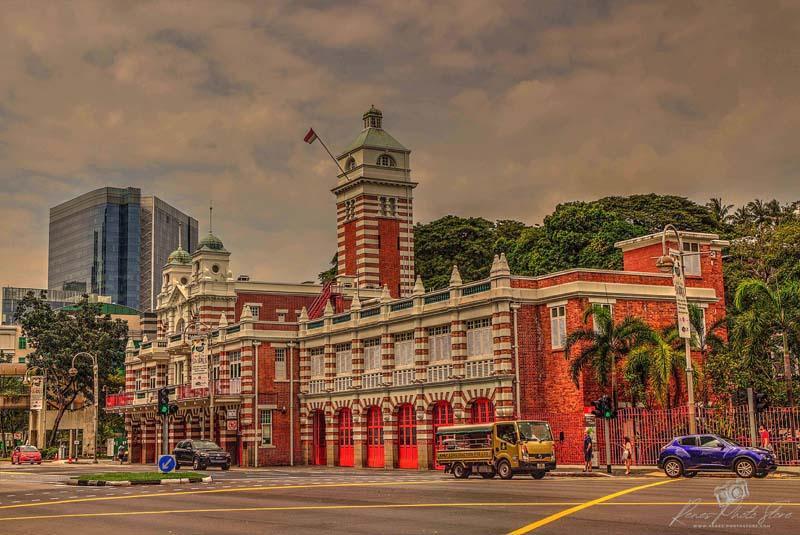The Crimson Sentinel: A History of Singapore’s Central Fire Station
Amidst the gleaming skyscrapers and modern thoroughfares of Singapore’s Civic District stands a striking beacon of history, painted in bold bands of red and white. The Central Fire Station is more than just a functioning firehouse; it is a monument to resilience, a testament to the modernization of a city, and an enduring symbol of courage. Its story is not written in its bricks and mortar alone, but in the echoes of clanging bells, the shouts of brave firefighters, and the countless emergencies it has answered for over a century.
From Flames to Formation: The Need for a Modern Brigade
To understand the significance of the Central Fire Station, one must first picture Singapore at the turn of the 20th century. A bustling colonial port, the city was a tinderbox of densely packed shophouses constructed from timber and attap (palm thatch). Fires were frequent and devastating. The Great Fire of 1851, for instance, razed a third of Singapore’s colonial town to the ground. The existing volunteer fire brigades, though brave, were poorly equipped and disorganized, often arriving at scenes with incompatible hoses and equipment.
The turning point came with a series of catastrophic fires in 1905 and 1907, including a massive blaze at the New World Amusement Park. The colonial government could no longer rely on ad-hoc measures. The solution was clear: a professional, centrally located, and technologically advanced fire brigade was imperative. The man tasked with this Herculean effort was Captain Montague William Pett, a Superintendent of Police who was also placed in charge of the fire services. Pett designed and oversaw the construction of what was to become the nerve center of Singapore’s firefighting efforts for generations to come.
An Architectural Marvel in Brick and Blood-Red
Completed in 1909, the Central Fire Station was a marvel of its time. Its design was a pragmatic and symbolic blend of form and function, conceived by the Public Works Department.
The most iconic feature, its vibrant red and white bichrome façade, was not merely an aesthetic choice. The red-and-white style, seen in other contemporary buildings like the old Hill Street Police Station, was a distinctive mark of British colonial civic architecture in Singapore. While stunning, the colors also served a purpose: the building was impossible to miss, a constant and reassuring landmark for the public.
Architecturally, it is a splendid example of the Edwardian style, which embraced a more restrained and functional classicism compared to the earlier, more ornate Victorian era. You can see this in the elegant arched windows, the robust brickwork, and the symmetrical layout. The centerpiece is undoubtedly the watch tower. This tall, square tower was the station’s eyes and ears. Before the age of radio and telephones, watchmen would scan the horizon from this vantage point, ready to slide down the iconic brass pole the moment they spotted smoke.
This very pole, one of the first of its kind in Southeast Asia, was a revolutionary import that symbolized the station’s cutting-edge nature. It allowed firefighters stationed on the upper floors—where their living quarters were—to descend to the ground-floor engine bay in seconds, shaving precious time off their response. The ground floor itself was engineered with a slight slope, allowing water to drain easily after the engines were hosed down, a clever detail that speaks to the thoughtful design.
Answering the Call: A Century of Service
The Central Fire Station was inaugurated with the latest technology: steam-powered fire engines, horse-drawn until motorized engines were introduced in the 1920s. The sound of its bell became synonymous with hope in moments of crisis.
Its history is woven into the fabric of Singapore’s timeline. The station and its crews battled immense blazes throughout the 20th century, from warehouse fires to wartime emergencies. During World War II, amidst the chaos of the Japanese invasion, these firefighters displayed incredible bravery, continuing their duty even as bombs fell on the city. In the post-war years, as Singapore modernized, so did the station, upgrading its equipment to handle new challenges posed by a growing skyline of high-rises and industrial complexes.
Perhaps one of its most significant roles, which solidified its place in the heart of the community, was its function during the tumultuous 1950s and 60s. Beyond fires, the station’s engines were often used to supply water to neighborhoods during severe droughts, a lifeline for parched residents.
The Living Museum: The Civil Defence Heritage Gallery
While still a working fire station today, home to the 1st Response Division of the Singapore Civil Defence Force (SCDF), its historical signifance has been proudly preserved. In 2001, the station’s frontage and the old engine bay were converted into the Civil Defence Heritage Gallery.
Stepping inside is like walking through time. The gallery meticulously charts the evolution of firefighting in Singapore, from its humble beginnings to the high-tech force it is today. Visitors can marvel at the antique fire engines, including a beautifully restored 1930s Merriweather fire engine, examine vintage equipment, and even experience a simulated bomb shelter from the war years. It’s a place where history is not behind glass but felt in the very air, mingling with the faint smell of polish and the palpable sense of duty.
The Central Fire Station is a rarity—a historic building that has never ceased fulfilling its original, vital purpose. It is a steadfast crimson sentinel that has watched over Singapore through colonialism, war, independence, and its meteoric rise to a global metropolis. It represents a promise made in 1909: a promise of protection, of order, and of courage in the face of danger.
This moment, captured in a high-resolution photograph, is available as a digital download for your home or project. The image encapsulates the grandeur and history of this iconic landmark, perfect for creating a striking piece of wall art or for use in a design project. To own a piece of this history and bring the story of the Crimson Sentinel into your space, simply follow this link: CLICK HERE



